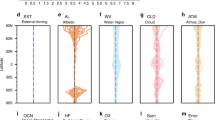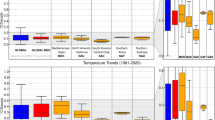Abstract
Uncertainty in the spatial pattern of climate change is dominated by divergent predictions among climate models. Model differences are closely linked to their representation of climate feedbacks, that is, the additional radiative fluxes that are caused by changes in clouds, water vapour, surface albedo, and other factors, in response to an external climate forcing. Progress in constraining this uncertainty is therefore predicated on understanding how patterns of individual climate feedbacks aggregate into a regional and global climate response. Here we present a simple, moist energy balance model that combines regional feedbacks and the diffusion of both latent and sensible heat. Our model emulates the relationship between regional feedbacks and temperature response in more comprehensive climate models; the model can therefore be used to understand how uncertainty in feedback patterns drives uncertainty in the patterns of temperature response. We find that whereas uncertainty in tropical feedbacks induces a global response, the impact of uncertainty in polar feedbacks remains predominantly regionally confined.
This is a preview of subscription content, access via your institution
Access options
Subscribe to this journal
Receive 12 print issues and online access
$259.00 per year
only $21.58 per issue
Buy this article
- Purchase on Springer Link
- Instant access to full article PDF
Prices may be subject to local taxes which are calculated during checkout



Similar content being viewed by others
References
Charney, J. G. et al. Carbon Dioxide and Climate: A Scientific Assessment 22 (National Academy of Sciences, 1979).
Hansen, J. E. et al. in Climate Processes and Climate Sensitivity (eds Hansen, J. E. & Takahashi, T.) 130–163 (American Geophysical Union, 1984).
Schlesinger, M. E. in The Potential Climatic Effects of Increasing Carbon Dioxide (eds MacCracken, M. & Luther, F.) 81–147 (US Dept. of Energy, 1985).
Meehl, G. A. et al. The WCRP CMIP3 multi-model dataset: A new era in climate change research. Bull. Am. Meteorol. Soc. 88, 1383–1394 (2007).
Zelinka, M. A. & Hartmann, D. L. A diagnostic study of climate feedback processes in atmospheric general circulation models. J. Clim. 25, 608–624 (2012).
Soden, B. J. & Vecchi, G. A. The vertical distribution of cloud feedback in coupled ocean–atmosphere models. Geophys. Res. Lett. 38, L12704 (2011)
Bony, S. & Dufresne, J. L. Marine boundary layer clouds at the heart of cloud feedback uncertainties in climate models. Geophys. Res. Lett. 32, L20806 (2005).
Feldl, N. & Roe, G. H. The nonlinear and nonlocal nature of climate feedbacks. J. Clim. 26, 8289–8304 (2013).
Huang, Y. & Zhang, M. The implication of radiative forcing and feedback for meridional energy transport. Geophys. Res. Lett. 41, 1665–1672 (2014).
Hwang, Y-T. & Frierson, D. M. W. Increasing atmospheric poleward energy transport with global warming. Geophys. Res. Lett. 37, L24807 (2010).
Flannery, B. P. Energy balance models incorporating transport of thermal and latent energy. J. Atmos. Sci. 41, 414–421 (1983).
Rose, B. E. J. et al. The dependence of transient climate sensitivity and radiative feedbacks on the spatial pattern of ocean heat uptake. Geophys. Res. Lett. 41, 1071–1078 (2014).
Bony, S. et al. How well do we understand and evaluate climate change feedback processes? J. Clim. 19, 3445–3482 (2006).
Soden, B. J. & Held, I. M. An assessment of climate feedbacks in coupled ocean atmosphere models. J. Clim. 19, 3354–3360 (2006).
Roe, G. H. Feedbacks, time scales, and seeing red. Annu. Rev. Earth Planet. Sci. 37, 93–115 (2009).
Roe, G. H. & Armour, K. C. How sensitive is climate sensitivity? Geophys. Res. Lett. 38, L14708 (2011)
Feldl, N. & Roe, G. H. Four perspectives on climate feedbacks. Geophys. Res. Lett. 40, 4007–4011 (2013)
Boer, G. J. & Yu, B. Climate sensitivity and climate state. Clim. Dynam. 21, 167–176 (2003).
Crook, J. A., Forster, P. M. & Stuber, N. Spatial patterns of modeled climate feedback and contributions to temperature response and polar amplification. J. Clim. 24, 3575–3592 (2011).
Armour, K. C., Bitz, C. M. & Roe, G. H. Time-varying climate sensitivity from regional feedbacks. J. Clim. 26, 4518–4534 (2013).
Mauritsen, T. et al. Climate feedback efficiency and synergy. Clim. Dynam. 41, 2539–2554 (2013).
Graversen, R. G. & Wang, M. Polar amplification in a coupled climate model with locked albedo. Clim. Dynam. 33, 629–643 (2009).
Roe, G. H. & Baker, M. B. Why is climate sensitivity so unpredictable? Science 318, 629–632 (2007).
Frierson, D. M. W., Held, I. M. & Zurita-Gotor, P. A gray-radiation aquaplanet moist GCM. part II: Energy transports in altered climates. J. Atmos. Sci. 64, 1680–1693 (2007).
Vallis, G. K. Atmospheric and Oceanic Fluid Dynamics (Cambridge Univ. Press, 2006).
Kidston, J., Dean, S. M., Renwick, J. A. & Vallis, G. K. A robust increase in the eddy length scale in the simulation of future climates. Geophys. Res. Lett. 37, L03806 (2010).
O’Gorman, P. A. Understanding the varied response of the extratropical storm tracks to climate change. Proc. Natl Acad. Sci. USA 107, 19176–19180 (2010).
North, G. R., Cahalan, R. F. & Coakley, J. K. Jr Energy balance climate models. Rev. Geophys. 19, 91–121 (1981).
Hwang, Y-T., Frierson, D. M. W. & Kay, J. E. Coupling between Arctic feedbacks and changes in poleward energy transport. Geophys. Res. Lett. 38, L17704 (2011).
Frierson, D. M. W. & Hwang, Y-T. Extratropical influence on ITCZ shifts in slab ocean simulations of global warming. J. Clim. 25, 720–733 (2012).
Chiang, J. C. H. & Bitz, C. M. Influence of high latitude ice cover on the marine Intertropical Convergence Zone. Clim. Dynam. 25, 477–496 (2005).
Pausata, F., Battisti, D. S., Nisancioglu, K. N. & Bitz, C. M. Chinese stalagmites: Proxies for the Indian monsoon response to an archetypal Heinrich event. Nature Geosci. 4, 474–480 (2011).
Deser, C., Phillips, A. S., Bourdette, V. & Teng, H. Uncertainty in climate change projections: The role of internal variability. Clim. Dynam. 38, 527–546 (2012).
Hawkins, E. & Sutton, R. The potential to narrow uncertainty in regional climate predictions. Bull. Am. Meteorol. Soc. 90, 1095–1107 (2009).
Caballero, R. & Hanley, J. Midlatitude eddies, storm-track diffusivity and poleward moisture transport in warm climates. J. Atmos. Sci. 69, 3237–3250 (2012).
Caballero, R. & Huber, M. State-dependent climate sensitivity in past warm climates and its implications for future climate projections. Proc. Natl Acad. Sci. USA 110, 14162–14167 (2013).
Wu, Y. et al. Changes in storm tracks and energy transports in a warmer climate simulated by the GFDL CM2.1 model. Clim. Dynam. 37, 53–72 (2011).
Holland, M. M. & Bitz, C. M. Polar amplification of climate change in the coupled model intercomparison project. Clim. Dynam. 21, 221–232 (2003).
Webb, M. J., Lambert, F. H. & Gregory, J. M. Origins of differences in climate sensitivity, forcing and feedback in climate models. Clim. Dynam. 40, 677–707 (2013).
Feldl, N., Frierson, D. M. W. & Roe, G. H. The influence of regional feedbacks on circulation sensitivity. Geophys. Res. Lett. 41, 2212–2220 (2014).
Held, I. M. & Soden, B. J. Water vapor feedback and global warming. Annu. Rev. Energy Environ. 25, 441–475 (2000).
Acknowledgements
The authors are grateful for enlightening feedback from M. Baker, A. Donohoe and P. Molnar.
Author information
Authors and Affiliations
Contributions
G.H.R. performed the MEBM analyses and N.F. performed the AM2 integrations. All authors contributed to the interpretation of the results and to writing the manuscript.
Corresponding author
Ethics declarations
Competing interests
The authors declare no competing financial interests.
Supplementary information
Supplementary Information
Supplementary Information (PDF 279 kb)
Rights and permissions
About this article
Cite this article
Roe, G., Feldl, N., Armour, K. et al. The remote impacts of climate feedbacks on regional climate predictability. Nature Geosci 8, 135–139 (2015). https://doi.org/10.1038/ngeo2346
Received:
Accepted:
Published:
Issue Date:
DOI: https://doi.org/10.1038/ngeo2346
This article is cited by
-
The sensitivity of climate and climate change to the efficiency of atmospheric heat transport
Climate Dynamics (2024)
-
Seasonal temperatures in West Antarctica during the Holocene
Nature (2023)
-
Soil hydrology in the Earth system
Nature Reviews Earth & Environment (2022)
-
Feedbacks and eddy diffusivity in an energy balance model of tropical rainfall shifts
npj Climate and Atmospheric Science (2020)
-
How far poleward can the seasonal precipitation maxima over land extend under high obliquity?
Climate Dynamics (2020)



